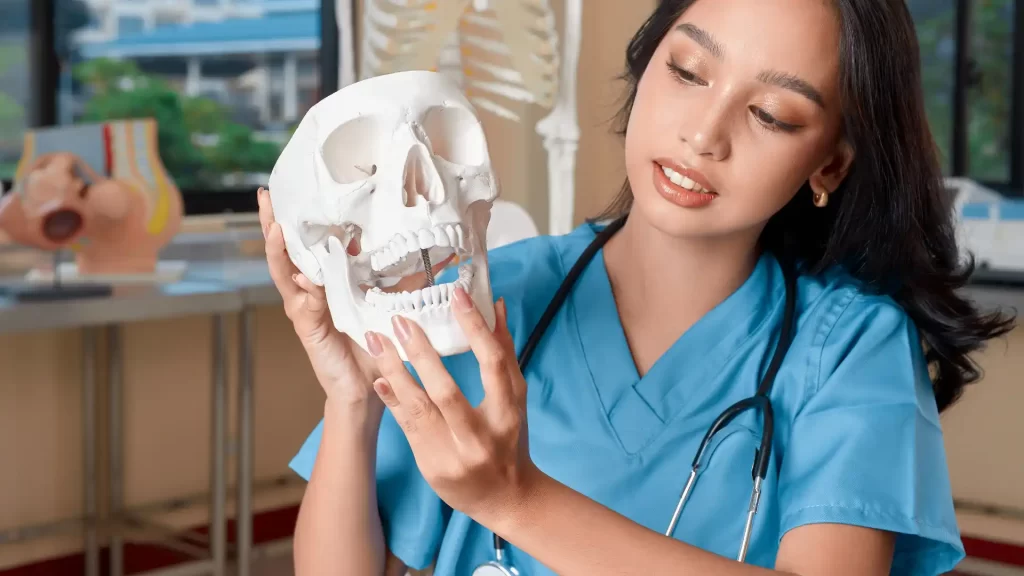We bring you a vast guide on how to correct misaligned jaws using dental treatments! Sometimes biting, alignment discomfort and jaw pain are symptoms that patients erroneously try to ignore.
Maloccluded jaws are detrimental to both oral and general health, though there are solutions that are applicable. This guide will take you through all you need to know about treatments for misaligned jaws – from the symptoms to the types of treatments used. Whether you have TMJ pain that requires relief or your smile needs some fine-tuning, let’s start the journey towards better oral health!
What are the Identifiable Misaligned Jaw Symptoms?
The early identification of a misaligned jaw can be very critical. Symptoms can take different forms affecting both oral health and general well-being.
One common sign is the trouble in biting, leading to discomfort or pain sometimes. Further, some of the people can see that their teeth are not aligned correctly or their bite pattern tends to change. Facial asymmetry is another sign of misalignment, when one side seems larger or protrudes more than the other. In addition, long-lasting headaches, jaw clicking, or popping noises, and ear aches can be due to misalignment of the jaw.
It is very important to notice these signs and get a professional assessment when any signs of significant As these early indications can help in making a timely and proper intervention in order to prevent further problems.
How do You Know If Your Jaw is Misaligned?
Diagnosis of the misaligned jaw is based on physical manifestations as well as functional constraints. Another sign is the uncomfortable task of opening or closing the jaws fully with pain.
Alignment of your teeth can also be seen; irregularities such as overbites, underbites, or crossbites could signal jaw misalignment. However, facial asymmetry or changes in the contour of the jawline may indicate other problems. Noting any clicking, popping, or grating sounds when the jaw is moved, as well as frequent headaches or earaches, can also help to strengthen the suspicions of jaw misalignment.
It is recommended that a person consults a dental or medical professional for a full evaluation in order to get an accurate diagnosis and to address any potential concerns.
What Causes Misaligned Jaw?
Recognition of the underlying reasons of misaligned jaw important for successful treatment and prevention approaches. Various causes can be associated with this situation, from developmental problems to habits, as well as traumatic injuries. Temporomandibular Joint (TMJ) Disorder is one of the top offenders, representing dysfunction or inflammation of the jaw joint and their muscles.
Bruxism, more commonly known as teeth grinding can put too much pressure on the jaw causing misalignment with time. Other traumatic events, e.g. accidents or sport injuries, may also change the natural position of the jaw. Myofascial Pain Syndrome, which is a condition of muscles that is associated with pain and stiffness, can either worsen the misalignment that already exists or be the cause of the misalignment.
Furthermore, irregular bites where the teeth don’t meet properly, and congenital defects also have considerable roles. These diverse etiologies, however, emphasize the necessity of individualized treatment modalities crafted to suit each patient’s different situations.
What to Do If Your Jaw Feels out of Alignment?
Resolving a feeling of misaligned jaw involve a reactive approach meant to alleviate pain and return proper function. Professional advice from a dentist, orthodontist, or oral surgeon is essential for right diagnosis and personalized treatment suggestions. The solution will depend on the cause and degree of the misalignment.
In the meantime, ice packs or warm compresses can be used on the area to help to reduce pain and inflammation. OTC painkillers may also provide relief of symptoms, but do not address the underlying problem. The use of relaxation techniques like deep breathing or meditation can control the jaw-joint tension induced by stress.
Furthermore, hard, sticky foods and an appropriate posture help control the overload of the joint and surrounding muscles. But for a long term solution, professional intervention could be in form of orthodontic devices, and even surgeries. Close cooperation with healthcare practitioners guarantees a thorough and efficient approach to the problem of jaw misalignment and the healthy state of the dental system.
Temporomandibular Joint (TMJ) Disorder
TMJ Disorder which is basically pain and dysfunction in the jaw joint and the surrounding muscles is a common cause of jaw misalignment. This situation may appear in many ways, such as trouble in opening and closing the mouth, sound that comes when moving the jaw and even chronic facial pain.
The factors that can cause TMJ disorder include bruxism, arthritis, jaw injuries, or structural abnormalities in joint.
Bruxism
Bruxism is one of the major risk factors for jaw misalignment. This deviant behavior can produce too much pressure on the teeth and jaw joint making them worn, muscles to be tense and having misalignment problems eventually. A lot of people may not know that they grind their teeth since this usually happens in sleep or during stress.
Nevertheless, typical symptoms include worn tooth enamel, jaw pain, headaches, and flattened or chipped teeth. Bruxism is usually managed through a multidisciplinary approach of behavioral changes, stress reduction strategies, and dental treatments. Mouthguards or splints may be recommended to guard the teeth and remove pressure from the jaw joint.
Furthermore, relieving the underlying stress or anxiety with relaxation exercises or counseling can help in breaking the bruxism habit and protecting the jaw from further damage.
Trauma or Injury
Trauma events like sports injuries, car accidents or falls, can cause the jaw to lose its natural harmony and be misaligned. The consequence of such events is fractures, dislocations, or impairment of the supporting structures of the jaw joint causing functional impairment or pain. Signs of jaw misplacement after trauma can be troubles with opening or closing the mouth, swelling, bruising, and soreness around the jaw-line.
In these instances, timely and quick medical care is paramount to determine the severity of injury and start appropriate treatment.
The interventions that may be employed will depend on the severity of the trauma and may vary from conservative measures such as rest, ice, and pain medication to surgical repair or reconstruction of the affected area. Rehabilitation and physiotherapy might also be advised to return normal function and avoid long-term complications.
Myofascial Pain Syndrome
MPS may be a factor in jaw misalignment in the sense of chronic muscle pain and tension. This type of condition is characterized by the formation of trigger points or “knots” within the muscles, which causes local pain and movement limitation.
MPS may be produced by some factors which include muscle overuse, improper sitting, stress, or some medical problems. In the setting of jaw misalignment, myofascial trigger points add another layer of complexity to symptoms and slow down the process of treatment.
The treatment of MPS usually includes a multimodal approach which consists of manual therapies, trigger point injections, and stretching exercises and management techniques. Taking care of the contributing factors like poor ergonomics or muscle imbalances is also important in providing long-term symptom relief and prevent recurrence.
Malocclusion
Malocclusion is a situation when the teeth do not take up the right position meaning that the upper and lower dental arches do not fit together well when biting or mouth.
This problem can arise from a number of situations which may include genetics, developmental faults, or habits like thumb sucking and tongue thrusting. Functional problems and discomfort can develop when malocclusion changes the pattern of forces during chewing and speaking, resulting in jaw misalignment. The common malocclusions are overbites, underbites, crossbites, and crowding of teeth.
Congenital Birth Defects
Jaw and facial structural anomalies that are congenital at birth may cause deviations and functional problems in the early years.
Cleft lip and palate, mandibular hypoplasia, or craniofacial syndromes are types of condition that may interfere with proper development and positioning of the jaw, thus presenting to significant issues in feeding, speech, and oral function. The treatment of congenital jaw defects is usually a multidisciplinary approach, which is conducted by a team of specialists including pediatricians, oral surgeons, orthodontists, and speech therapists.

What are the Treatments for Misaligned Jaw ?
The treatment of misalignment of the jaw usually involves several line of approach adapted to the causes of the problem and specific patient requirements. Multiple treatment approaches are utilized, beginning with conservative and continuing through to surgical interventions, all with the intention of bringing alignment, functionality and oral health.
Braces
Braces are one of the most widespread orthodontic therapy methods, used for the correction of the wrongly placed teeth and jaws. The correct alignment of the teeth within the dental arches is achieved as braces apply controlled forces to the teeth gradually repositioning them.
This procedure solves matters like overbites, underbites, crossbites and overcrowding, thus enhancing the dental aesthetics as well as functionality. Braces are made up of brackets attached to the teeth and linked by wires, which are regularly adjusted by an orthodontist to direct teeth movement.
Clear Aligners
The clear aligners provide such patients with a convenient and inconspicuous substitution for the traditional braces. Made specially and transparent, these trays are worn on teeth and as force is controlled on them, one by one, they are shifted to the right position. Because clear aligners are removable, patients can manage an easier oral hygiene and feel less discomfort than patients who wear braces.
Bridges
Dental bridges offer a restorative answer for missing teeth replacement and proper dental occlusion restoration in situations of jaw misalignment. A bridge is a series of one or more pontics that are artificial teeth supported by natural teethe and similarly dental implants. Bridges through filling the spaces created by missing teeth, help in proper alignment of the remaining teeth and also preventing them from shifting or tilting that can contribute to the jaw misalignments over time.
Misaligned Jaw Surgery
When jaw misalignment is severe or complex such that orthodontic appliances alone will not be able to set them right, surgical intervention might be required.
In orthognathic surgery, also called corrective jaw surgery, the upper jaw (maxilla), lower jaw (mandible), or both of them are repositioned for proper alignment and functional harmony.
This procedure is usually carried out as a part of orthodontic therapy to maximize the results as well as to ensure stability. Severe overbites, underbites, facial asymmetry, and breathing difficulties prevailing in jaw misalignment can be corrected by the orthognathic surgery.
Although surgery may involve a prolonged recovery and more risks compared with non-surgical interventions, it can provide a truly transformational outcome and long-term improvement of oral function and aesthetics.

Treatment of Jaw Misalignment Pain
The management of jaw misalignment pain is an integrated approach that deals with both symptomatic relief as well as underlying causes. Numerous measures can be taken to eliminate pain, restore jaw function and achieve general health.
In chronic and recurrent pain, lifestyle modifications including stress management techniques, dietary changes, and ergonomic adjustments are beneficial in reducing triggers and improving symptoms. Soft or tough to chew foods that aggravate jaw pain are to be avoided and relaxation exercises including deep breathing, or meditation can help in reducing muscle tension.
In some cases, dental modalities, including orthodontic appliances, occlusal splints, or bite adjustments, could be suggested to correct the underlying alignment problems and relieve the pressure on the jaw joint. The purpose of these treatments is to improve dental occlusion, provide a balanced distribution of biting forces, and lessen the stress on the temporomandibular joint (TMJ).
In the end, pain management in case of a jaw misalignment is an individual approach, which should cover the patient’s requests and concerns. Together with conservative treatment approaches, dental interventions, and multidisciplinary pain management strategies, healthcare providers can treat pain, improve jaw function, and enhance overall quality of life in patients with malocclusions.











